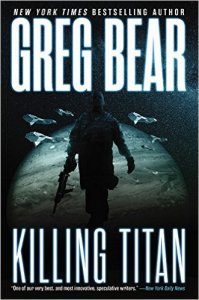Paul Di Filippo Reviews 2020 Vision, Edited by Jerry Pournelle
 2020 Vision, Jerry Pournelle, ed. (Avon Books 18390, $.95, 192pp, paperback) February 1974
2020 Vision, Jerry Pournelle, ed. (Avon Books 18390, $.95, 192pp, paperback) February 1974
Friedrich Nietzsche famously opined, “If you gaze long enough into an abyss, the abyss will gaze back into you.” I’d like to contribute a corollary observation: “When you stare into the future, you invite the future to stare back at you.” Every attempt at speculative forecasting, every probe of futurity, invites a look in the rear-view mirror from the inhabitants of that future, once the anticipated target era becomes realtime, the present day.
And so here we are in the quintessentially stefnal-sounding year of 2020, looking back forty-six years to the 1974 appearance of an anthology helmed by Jerry Pournelle and aimed squarely at our present day. And our first response to the book must invariably be, “Why did they not publish this in 1970, to make a nicely rounded fifty-year look-ahead?” This book’s entry at ISFDB offers a relevant tidbit: “This began as an original anthology with most of the work commissioned in 1971. By the time it was published (due to publisher delays) five of the eight stories had already been published elsewhere.” Okay, so we can blame the publisher for a three-year delay. (And also for the baffling uncopyedited reference once or twice in the text to 20/20 Vision as the title.) But still, c’mon, ghost of Originating Editor Pournelle: shouldn’t you have commissioned everything in 1969, for a numerically resonant publication in 1970?
And addressing the ghost of Jerry Pournelle naturally summons up another observation: only three of the folks associated with this project are still with us: Larry Niven, Ben Bova, and Norman Spinrad. This sad rollcall of mortality is an inevitable concomitant of all such retrospective glances.
Putting aside these two extra-literary issues, we can turn our attention to the actual contents of the volume, and judge each item by two measures: literary excellence, and predictive accuracy.
First up is Pournelle’s “Preface” which is short and informal and chatty, and basically touts the abilities of the SF writer to see the future, while admitting the genre’s misfires. Our editor lays out his remit that he gave to the contributors—realistic stories of the year 2020 without wild card elements—and offers to buy a drink for anyone attending the 2020 Worldcon who shows up with a copy of this volume. A promise now sadly impossible to fulfill.
In his “Introduction: Do We Live in a Golden Age?” Pournelle switches hats and goes professionally futurological, complete with footnotes, as he tosses out his own thoughts on what’s ahead. He walks a cautious tightrope between optimism and pessimism, citing the usual crises of overpopulation and ecological ruin and inequality of resources and wealth. It’s disheartening to see his totally still applicable characterization of hardcore right-wingers (afraid of cultural degeneration and Big Government) and intractable left-wingers (afraid of fascism). Surprisingly for 1974—but, as it turned out, accurately—he does not trouble to forecast any world wars, seeming to sense that large-scale conflicts will become passé. He concludes with a subtle comment: “It could be that we’ll be richer in 2020 than we are now—and still see 1970 as The Golden Age.” That’s a sentiment I myself entertain daily.
Ben Bova’s “Build Me a Mountain” is part of his Kinsman series, and finds our astronaut protagonist exiled to Earth. He attends a chic cocktail party where the then-current and still-extant arguments about “wasting money in space while there are problems to be solved on Earth” plays out in a dialogue-rich scenario. A low-key thinkpiece, the tale makes few speculative stabs and so escapes obsolescence. Bova does score a point when he observes that once you abandon a space program it will be awfully hard to reboot it.
Really, you’d swear that Cory Doctorow was giving us a chapter from Walkaway in the next tale, Larry Niven’s hip, jazzy, streamlined “Cloak of Anarchy”. The venue is a grassy, tree-studded section of the San Diego Freeway which has been turned into a “Free Park,” a zone of liberty where anything goes except nonconsensual violence. This rule is enforced by “copseyes,” floating spheres with video cameras and sonic stunners. (Give Niven credit for foreseeing drone tech.) The milieu outside the park is lightly sketched—genetic engineering, political stability and, apparently, economic plenty. But Niven’s intention is to examine how fragile civilization actually is. When the copseyes go down and visitors are locked in the park, nature red in tooth and claw quickly reasserts itself. Does anyone else think of New Orleans after Katrina hit?
In his blog post titled “World building 404: The unknown unknowns“, Charles Stross very helpfully gives a handy formula for writing near-future SF: “Here’s my recipe for building a near-future world… Start with a horizon 10 years out: 85% known knowns; 10% known unknowns; 5% unknown unknowns.” Obviously, the percentages shift as you head further out. But the point remains that most of your near future will be obvious extrapolations from current conditions. In “Silent in Gehenna”, Harlan Ellison—arguably at the peak of his powers—foregoes any Strossian complexities and instead focuses laser-like on just one single aspect of the Seventies—Weathermen-style protest/sabotage/terrorism—and ramps it up to eleven, giving us Joe Bob Hickey, professional social justice warrior, fighting the Establishment with every breath. A climactic turn into almost HPL “Shadow Out of Time” territory finds Hickey’s martyr instincts given full scope.
In “The Pugilist” Poul Anderson builds the most elaborate realpolitik, future history scenario in the volume, giving us the People’s Republic of the United States, founded after the Sacred War. While logical and well-informed, Anderson’s geopolitical chart fell apart thanks to the collapse of Communism. Nevertheless, his future feels like a plausible alternate to our own. A rebel named Dowling is captured by the government, tortured by the surgical removal of his penis, which is then replaced by a prosthetic weapon, and sent to bring in his comrades. Never let it be said Anderson had no sense of humor or gonzo impulses. Score a prophetic point for this: “We have millions of computers around these days, nationally interconnected.”
Primarily a Big Name Fan, Dian Girard (later, Dian Girard Pelz Crayne) had a smallish fiction-writing career. In “Eat, Drink, and Be Merry” she goes the Sheckley route, offering an underground nanny state which ruthlessly limits the housewife protagonist’s caloric intake for her own good. In our day of bans on vaping and taxes on high-sugar beverages, this Kit Reed-style sardonicism rings true.
Dead at a young age, alas, just a few years after this book came out, David McDaniel regrettably spent most of his career turning out franchise fiction. A shame, for “Prognosis: Terminal” reveals a keen speculative grasp and some catchy prose stylings. Again, one might imagine Cory Doctorow handling this same material. Buzz Hoffer wants to earn his living through his passion for art. But unpaid amateurs have ruined his chances (cue Wattpad and Archive of Our Own here). Can he get access to a Cineborg machine to turn out synthesized productions and win a rep? Although our year of 2020 does not feature moving “pedways” or domed cities, almost everything else about this sharp tale seems accurate. And hey, “pocket phones” exist! So much for SF totally failing to visualize that revolution!
Universal Basic Income, anyone? When you turn eighteen in the world of A.E. van Vogt’s “Future Perfect” you receive a million dollars. Too bad one of the prerequisites for the cash is a biological “sex lock” which can only be reversed upon a permanent mating with a government-selected partner. Steven Dalkins, typical van Vogtian mind-sport, manages to bring the whole system down.
Finally we come to “A Thing of Beauty” by Norman Spinrad. In the ruins of civil-war-decimated New York, a sharp real estate broker dealing in antiquities entertains a high-powered buyer from hegemonic Japan, and manages to sell the collector a certain legendary piece of property, thus further diminishing the shattered status of the USA even further. Can we map this scenario to current-day concerns about Chinese investments in North America and their global Belt and Road Initiative?
In the end, how do we score this collection? Along that first vector I cited, literary merit, I find all the stories exceptional and eminently entertaining and well-constructed. Nearly fifty years on, they still manifest the professional skills that went into their construction.
On the predictive front, we have the usual hits and misses, with the McDaniel and Spinrad pieces most resembling the lineaments of our current era. But as I tried to indicate in my individual synopses, even the most far-out of these tales—the van Vogt, the Girard—resonate with one or two items from our reality. Nothing approaches the accurate genius of Brunner’s concurrent masterpieces, Stand on Zanzibar and The Sheep Look Up. But none of the stories were built simply to scare or warn or titillate; all of them attempt to conjure up a multiplex daily continuum where the perennial human joys and frustrations continue, and the specific challenges and rewards of 1974 undergo technology-abetted transmogrifications that only the toolkit of science fiction can vividly depict.
 While you are here, please take a moment to support Locus with a one-time or recurring donation. We rely on reader donations to keep the magazine and site going, and would like to keep the site paywall free, but WE NEED YOUR FINANCIAL SUPPORT to continue quality coverage of the science fiction and fantasy field.
While you are here, please take a moment to support Locus with a one-time or recurring donation. We rely on reader donations to keep the magazine and site going, and would like to keep the site paywall free, but WE NEED YOUR FINANCIAL SUPPORT to continue quality coverage of the science fiction and fantasy field.








This illustrates why I don’t do straight-up near-future SF. Even when my work -seems- like it is, I leave Easter Eggs to demonstrate that it’s actually an alternate history. Eg., in CONQUISTADOR, one character’s name reveals that in this history, John Rolfe and Pocahontas’ son himself had a surviving son, and that the family name survived down to the present.
This gives you total protection from the problem Paul outlines here.
Oh, the good old Kinsman series! One of the rare SF books that in some way foreshadowed the break-up of the Soviet Union. Bova was never one of my favorites but I have to give him that!
I won’t reveal much of a secret – this is about the US and Soviet Lunar colonies going independent from the parent-countries.